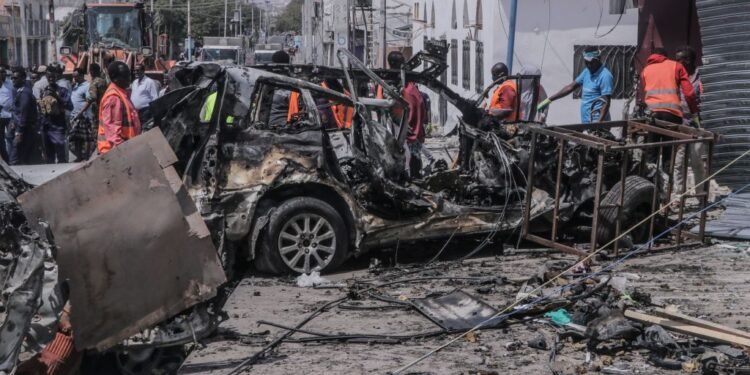
ADF STAFF
United Nations Deputy Secretary-General Amina Mohammed was among the many speakers who delivered stark assessments on extremist violence in Africa at a counterterrorism summit earlier this year in Abuja, Nigeria.
“The situation in Africa, particularly in the Sahel, is dire with some of the most violent terrorist groups operating in the Sahel; the region is now accounting for almost half of all deaths from terrorism globally,” she said.
Citing data from the African Centre for the Study and Research on Terrorism in Algeria, African Union Chairperson Mousa Mahamat highlighted some sobering numbers — an average of eight incidents and 44 fatalities per day on the continent in 2023.
There were more than 16,000 deaths in 2023, including more than 7,000 civilians and more than 4,000 security force members.
“Terrorism and violent extremism are the biggest evils of our time, spreading to all the five regions of Africa,” he said.

The threats posed by violent extremist organizations on the continent are constantly evolving, as the two most prominent ones — al-Qaida and the Islamic State group — exploit “a deficit in counterterrorism capabilities,” according to an August 13 report by a panel of U.N. experts.
“The situation is becoming ever more complex with the conflation of ethnic and regional disputes with the agenda and operations of these groups,” they wrote.
A series of infographics published by the Africa Center for Strategic Studies (ACSS) on August 13 showed how deaths from extremist militant violence have skyrocketed in some regions in recent years, while declining in others.
Sahel: The region with the fewest deaths 10 years ago has had the most over the last three years.
“The 11,200 deaths in the Sahel [through June 30] in 2024 — a tripling since 2021 — now represent over half of all reported fatalities across the continent,” the ACSS stated. “Security force violence against civilians has consistently been found to propel recruitment by violent extremist groups. The Sahelian military juntas and their militia allies have killed more civilians (2,430) in the past year than militant Islamist groups (2,050).”
The U.N. experts pointed to “a deficit in counterterrorism capabilities,” which al-Qaida and the Islamic State group affiliates continue to exploit.
Somalia: Al-Shabaab has existed for three decades and has made this struggling country the second-most-active battlefield on the continent for the last three years.
“The 6,590 reported fatalities in 2024 are more than double that of 2020,” the center wrote.
Al-Shabaab remains an overwhelming presence, as the Islamic State-Somalia group accounted for less than 1% of the terrorist activity in Somalia and Kenya this year. Despite significant losses from air strikes and military operations, “al-Shabab remains resilient.” It has an estimated 7,000 to 12,000 fighters and collects an estimated $100 million a year, mostly from taxation in Mogadishu and southern Somalia, the U.N. experts wrote.
Lake Chad Basin: A decade ago, this region was the epicenter of terrorist violence in Africa with 67% of all deaths, or 13,670 annually, according to the ACSS.
“Militant Islamist violence in the Lake Chad Basin (comprising northeast Nigeria and the borderlands of Cameroon, Niger and Chad) has ebbed and flowed over the past decade,” the report said. “The past two years have seen an increase in violent events after a period of decline. However, annual fatalities linked to these events have remained relatively consistent, typically ranging from 3,500 to 3,800 deaths.”
Mozambique: The northern province of Cabo Delgado has watched in horror as a local insurgency that emerged in 2017 has evolved into the deadly IS-Mozambique group. Multinational military operations have degraded the group’s capabilities, but violent events and fatalities have rebounded in the past year.
“The projected 250 events and 460 fatalities by the end of 2024 would represent a near doubling in violence over the previous year,” the center wrote.
North Africa: From June 30, 2014 to June 30, 2015 there were 3,650 fatalities from terrorism, second highest on the continent. This region now has the fewest reported deaths of the five.
“This year marks the first year there were no violent events linked to militant Islamist groups in Egypt since 2010,” the ACSS wrote. “The United Nations believes ISL (Islamic State-Libya) al-Qaida still have fighters in the southern part of the country, though they appear to be focused on profiting from the illicit economy.”
While Mohammed acknowledged the grim situation on the continent, she called on countries in and around these hotspots to work with the U.N. and other international organizations to address root causes of terrorism. She added that governments on the continent must reestablish their “social contract” or connection with communities and people.
“Terrorists find a welcome home with deeply disillusioned, excluded and desperate people,” she said. “When we create an environment where our youth can thrive, we can deter the disillusionment that leads some to believe joining terrorist groups like ISWAP [Islamic State-West Africa Province] or Boko Haram offers better opportunities than contributing to the development of their communities and continent.”
The post Threat of Extremist Groups Continues to Grow appeared first on Africa Defense Forum.










